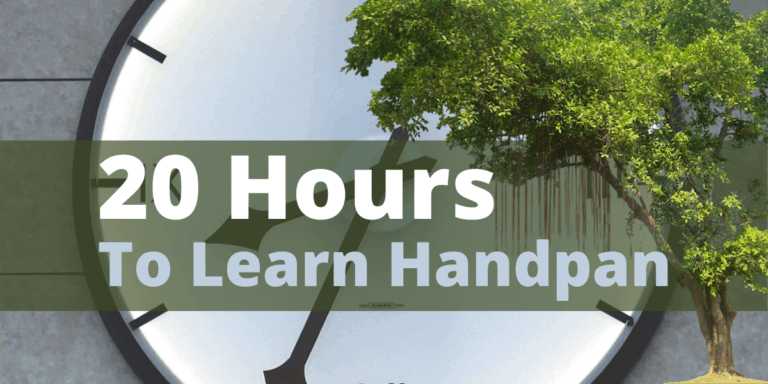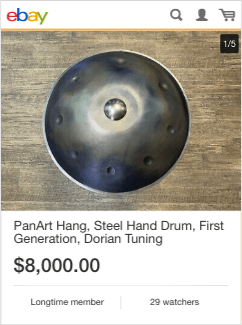Q. How Long Does it Take to Learn Handpan? A. Quicker than you Think!
As with any instrument, one thing to consider is just how much time you will have to dedicate to your new instrument and how long it will take to progress from novice to expert handpan player.
How long does it take to learn to play a handpan? – Because of the unique tuning methods with handpans, you will learn in a matter of weeks enough to play proficiently. The novice period with a handpan, unlike other instruments is very short. You’ll even be creating your own unique tunes in this time frame.
I’ll explain more in this article just how easy it is to learn to play the handpan. Also why it is simple and a few tips to make things happen even faster. For a shortcut, to organic learning, you could consider a video course to speed things up.
Why is Learning Handpan So Easy?
Let’s begin with one caveat. Playing a tune on a handpan is easy because of the scale and notation of the instrument. more on that later. The harder part might be mastering a rhythm, although even that does not matter as much as with other instruments.
This article is an overview of learning to play. For more detailed info on the first steps in learning handpan, take a look at my handpan lessons page.
I would also highly recommend buying the best handpan you can afford. handpans are not cheap, but if you go looking for a budget handpan, you may catch quite a cold.
Here is a guide to buying a handpan and the pitfalls to avoid
The Scale and Notation is a Huge Help
If we consider a basic 8 or 9 note handpan; the way the instrument is tuned overcomes the biggest obstacle in learning most other instruments. No matter which notes you hit, it is actually quite hard to hit a ‘bum’ note that doesn’t go with the one played previously, or indeed the next note you will play.
The handpan is tuned to a diatonic scale which all but negates that possibility, especially with the lower numbers note variations.
Within moments of sitting down with a handpan, you’ll tap a few notes and may surprise yourself with the tune you create, even before really getting to grips with where each note is.
OK, So I Can Play Some Notes but What Else Can I Learn
So yes. Just playing a few notes randomly and making some nice sounds is not becoming a handpan playing expert. There are a few techniques that will help you improve.
How to Strike the Handpan Notes
It is true to say that by simply striking a note on the handpan, such is the tuning, that you should get a nice sound with a clean tap. However, there is much more to each note on your instrument. much, much more!
How you strike the note will make a difference for sure. You will, through experience, learn the softer and heavier taps and how they affect the note and the resonance.
You may experiment, with connecting with the note with different parts of your hand. From fingertips to fuller strikes with more contact, or knocking a knuckle or two for yet another different tone.
The one thing you will want to avoid to prolong the accurate tuning is strike that is too hard. You’ll find that you do not have to be too firm with your instrument to get volume. Just go easy and build up how you play.
Perhaps trying playing up and down the scale with increasing and decreasing firmness to tune your ear in tandem with your playing.
Playing a Rhythm on a Handpan
A sense of rhythm is certainly an advantage to develop a style. If you have experience of other instruments, and in particular percussion instruments, you should be in possession of good rhythm already.
If you have experience with drums, of any kind, chances are you have learned rhythm patterns already. You can experiment with them on your handpan, around the tones and see what comes out.
There are some tips out and about suggesting using a metronome to keep time. I’m not a huge fan of the metronome. Not with the handpan at least. It’s a personal thing, but playing with a metronome does take a bit of feel out of playing and makes things sound a little more mechanical.
I suppose to begin with a metronome can help with keeping a beat, but do not get too used to playing with one.
Are There Handpan Lessons?
There are lessons online, and course that you can sign up for.
Due to the geographical difficulties caused by the scarcity of the instrument, and therefore willing teachers, virtually all courses, and video lessons are conducted online.
You’ll need to pay for access to a walled off website, or downloadable files with coaching tips hints, almost always via video.
Are Handpan Lessons Worth it?
A handpan video course can provide great value, in expediating your handpan playing ability in terms of rhythms, your feel, and ideas on how to develop your playing skills.
Learning some basic musical theory is going to be of benefit too, and again, will speed up the learning curve for sure.
It is not essential to pay for lessons, there are some free YouTube courses available and they provide some good basic techniques but you will get a more thorough learning experience from a good quality video course.
Once you have your new handpan in your lap, you are going to want to progress as quickly as possible. Trust me, your enthusiasm will always outpace your ability to progress.
Self-teaching with a little help from free courses online are going to certainly improve your playing skills, but if you want to keep pace with your enthusiasm, a professional course is going to repay you in terms of faster progress and value.
Handpan Tone and Rhythm
If you have little sense of rhythm and are tone-deaf, then I would say lessons would be essential. By the same token, they could actually be a total waste of time. If you have got this far without developing a sense of rhythm, you may not develop one, by coughing up hard-earned cash, most of which you’ve just spent on a handpan anyway. This is turning into a very expensive exercise for you.
In any case, if you suffer from either of the above brace of afflictions, chances are you are not even reading this or exploring the possibility.
Save that money, for now, have a play and develop your connection with your hand pan before committing to spending money on lessons.
Drum Rudiments
Here is one area of study that could benefit anyone and also provide you with some insight into how your handpan playing progression may go.
A rudiment is a small pattern. Say, left-right-left-right.
There are a number of basic rudiments, used and labeled drum rudiments, with varying patterns, using alternate left/right progression.
Because of the way the handpan notes are arranged, they can be very helpful in building rhythm patters on your hand pan.
Notation and Scale Playing on Handpan
So your rhythm is fine and you can hear the difference between the tones around your handpan.
Unlike a guitar or a piano, the handpan has very few notes. Sometimes, just 8 or 9. There is only so much you can do with these, although there are permutations of notes than can be played together to create other notes and chords. So it is a little more. You’ve certainly got no redundant notes like you would find on the guitar for instance.
This allows you to explore and experiment and find the majority of combinations and sounds that work well together to create your music. You’ll discover one, and hit will [excuse the pun], hit a chord with you. You will remember it and play it often. You may even base a brand new composition around that note you accidentally stumbled upon.
Musical Theory for Handpans
Now, this is where a lesson could come in handy. Playing any instrument is made far easier by having some theoretical musical knowledge.
It is no coincidence that someone who majored in music has the ability to pick up pretty much any instrument and within moments be playing something less offensive on it that if you had picked it up.
Understand how music works, how chords, notes, scales, work, what half step, 5ths, and semi-tones are, is a huge advantage in whatever instrument is played.
So if there was a strong argument for handpan lessons, it might be an investment in time and a small amount of money, to learn music theory. I’ve tried and failed. I just go sit in the woods, play my handpan, and even if the birds recognize it as rubbish, they’ve never told me!
Related Information
Can I get hang drum lessons near me?
You will be very fortunate to find local lessons on the handpan. As mentioned, searching on the internet for online courses may be the best course of action. Or maybe browse YouTube for handpan players, find the same scale instrument as yours, note how they play and copy.
Handpan sheet music?
Yes. You can use sheet music to play your handpan, and, even if you are not able to read sheet music, if it is in a particular form, you will be able to use it.
The one other thing that is essential is the notes on the handpan, have to be available to play on your handpan.
Rather than try to explain it here, take a look at David Urban’s video, where he explains it really clearly and well.
Best handpan players?
The best handpan player will, of course, have had many years of experience and probably developed their own inimitable style and sound.
Certainly, Daniel Waples, one of the most famous handpan players claims to have no musical knowledge and no coaching whatsoever and has learned to play his various handpans, alone with experimentation and performance alone.
I have another article on the best handpan players with accompanying videos. perhaps take a look. You’ll know what to aspire to, and maybe base your early style on trying to copy and learn the rhythms they play.







